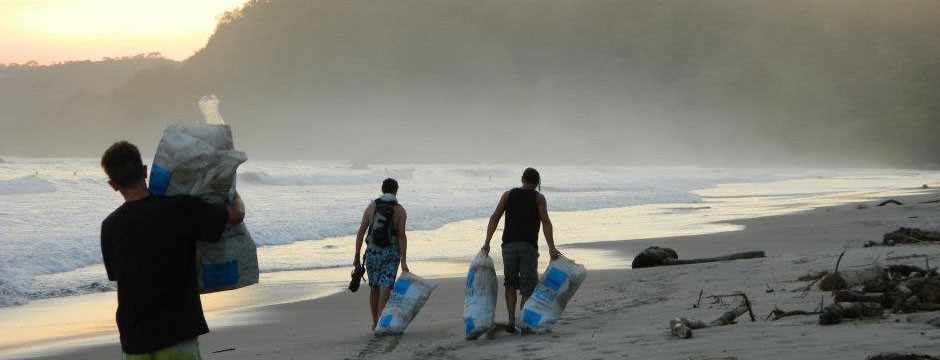Trash being dumped into the oceans is earning recognition as a growing danger. Efforts are being made to stop this practice. What are the reasons for beach trash and plastic becoming a bigger concern?
Marine debris comes from sources both on land and at sea. Indeed, Mother Nature also can put tons of debris into the oceans. Anyone who has visited the Nicoya coast after a heavy storm hit the land will see tons of trees and other materials piled up coming from Costa Ricans rivers. But most is biodegradable.
On the Central Pacific coast researchers express their concern that plastics are invading the oceans. The participation of Guanacaste beach communities in multiple clean-ups revealed that the majority of the items collected were food-related and plastic bags. The problem is, plastic never biodegrades. It only breaks down into small little balls of plastic, which the marine life ingests, and never leaves the oceans.
This concern finds support in the National Research Council findings:
“Marine debris, man-made materials that intentionally or accidentally enter and pollute the ocean, can cause significant harm. For instance, birds, fish, and marine mammals ingest debris, especially plastics, which can lead to digestive problems and uptake of toxic compounds. Animals can also suffer injuries or die after becoming entangled in fishing-related debris such as plastic net fragments, rope, and packing straps (…)”
[column col=”1/4″]
Top ten debris items collected in Costa Rica
1. Pull tabs (to open cans)
2. Straws and stirrers
3. Cigarettes and cigarette filters
4. Food wrappers and containers
5. Cups, plates, forks, knives, spoons
6. Bags
7. Beverage bottles (plastic)
8. Beverage cans
9. Cigarette lighters
10. Toys
[/column]
Source: National Research Council
While animals get entangled in it, for some organisms, plastic is also home. Plastic pollution in the ocean is harboring colonies of bacteria that could be harmful, not only to marine animals, but also to humans. Scientists have discovered colonies of bacteria, including some that they hadn’t expected. Those microbes are etching into the plastic composing a whole other ecosystem that is thriving on the plastic surface. The plastic acts as an artificial microbial reef and thus, harbor disease-causing pathogens and other harmful algal species.
As fish are ingesting some of that plastic debris, it is necessary to wonder if they are picking up certain toxins from the plastic or not? In this case, debris poses a health and safety hazard to beachgoers and divers, and could impact coastal recreation and tourism revenue.
Biologists working at the Ocotal Beach Resort, Costa Rica, provided the A.M Costa Rica magazine with a top ten list of man-made materials that pollute the beaches. These results show the need for more consciousness from people to properly dispose of their trash. A solution to this problem is to take a personal approach.
A few years ago, when Tropical Adventures still had its facilities established next to the beach of Puerto Viejo, employees would just take a bag with them on their walks and picking up plastic off the beach almost every day. Today, established in Hojancha we are still trying with the help of the people from the community to hold beach cleanups as often as we can. But we believe our most important part to take in this game is educating the kids we have here in Hojancha.
 Don’t forget that sometimes the smallest gestures make the biggest difference!
Don’t forget that sometimes the smallest gestures make the biggest difference!
Our next beach cleanup will take place in Playa Carrillo the 27th of July 2013, for more info please contact us!

